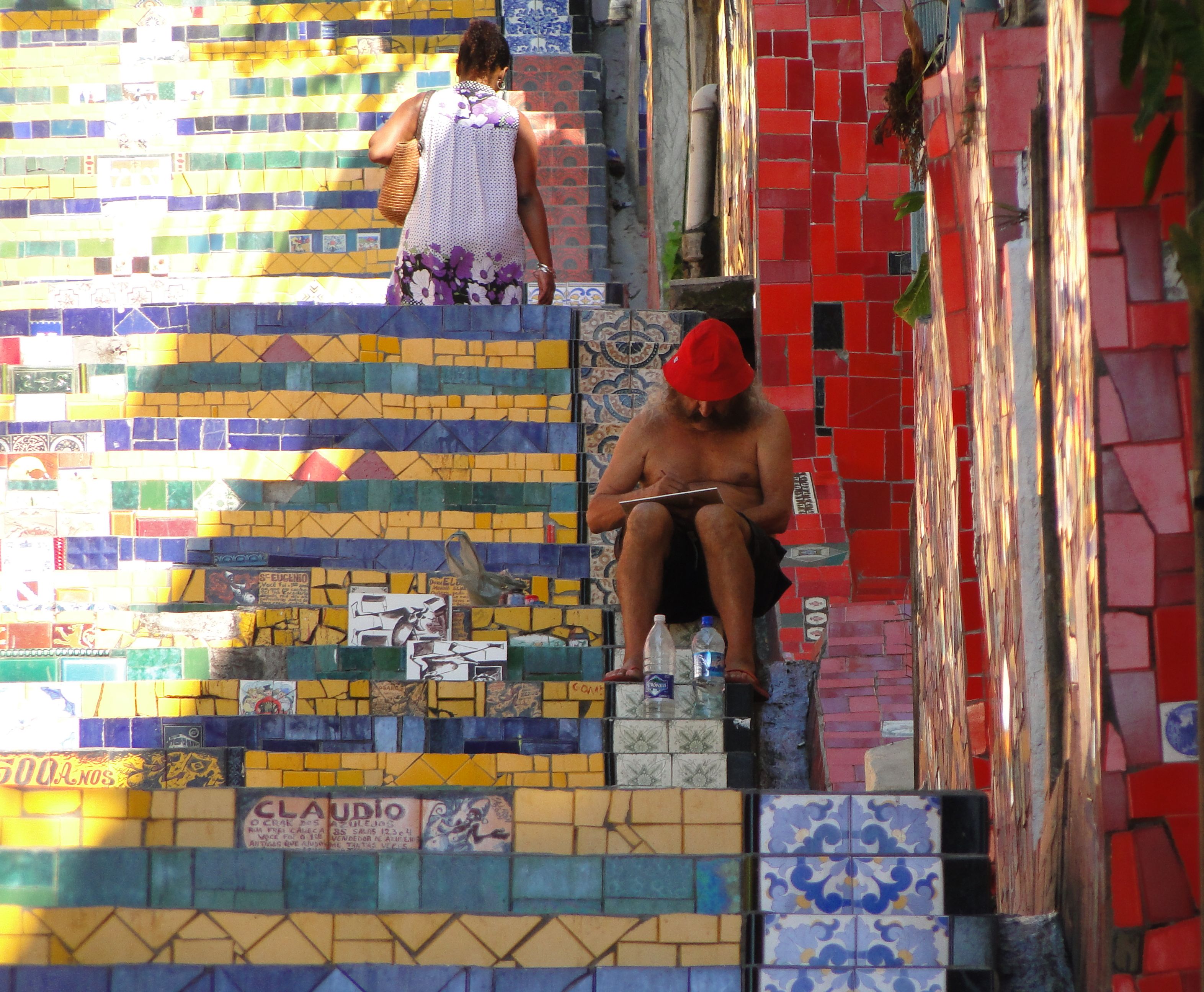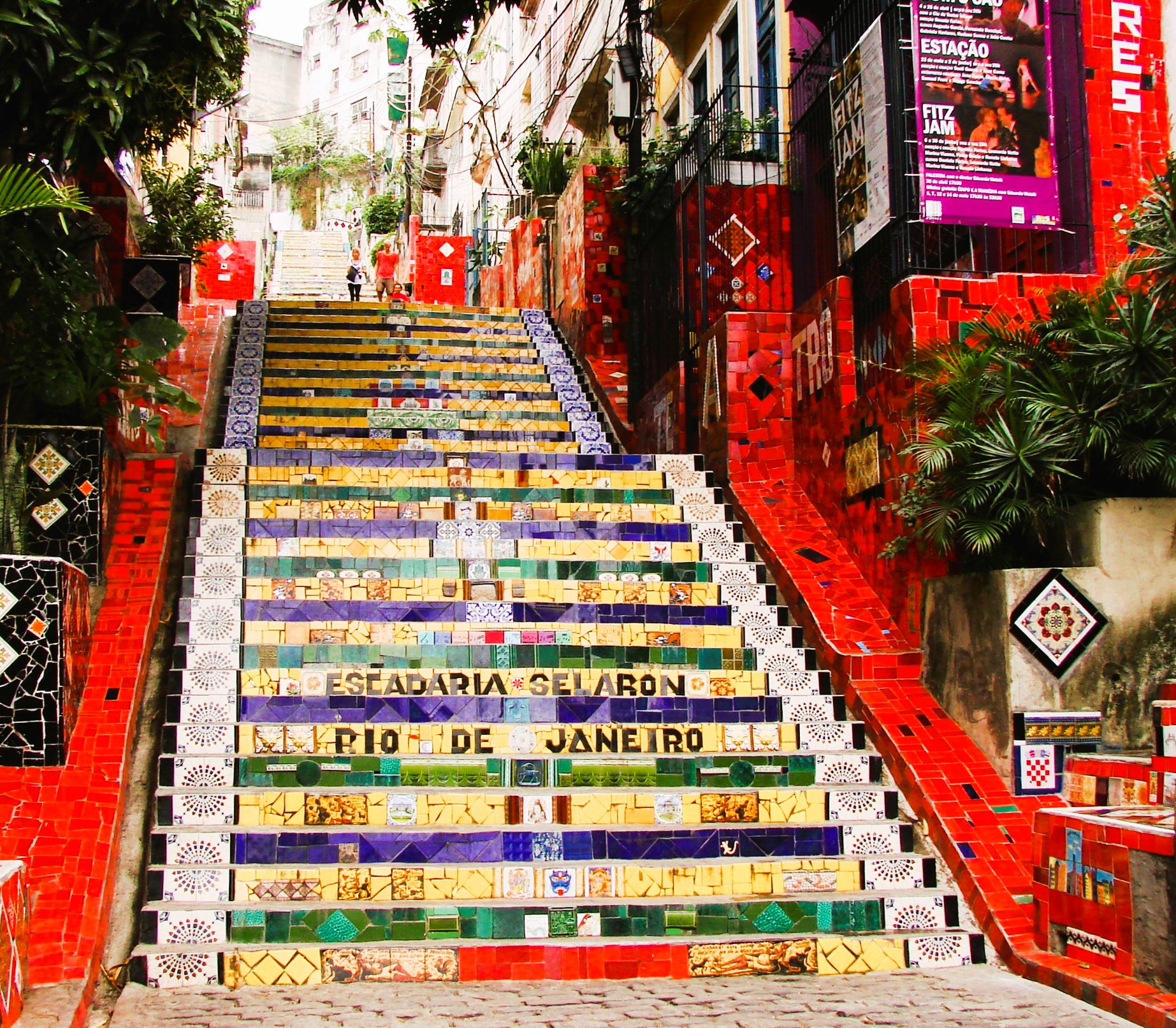Escadaria Selarón on:
[Wikipedia]
[Google]
[Amazon]
 Escadaria Selarón, also known as the 'Selaron Steps', is a set of world-famous steps in
Escadaria Selarón, also known as the 'Selaron Steps', is a set of world-famous steps in

 Escadaria Selarón, also known as the 'Selaron Steps', is a set of world-famous steps in
Escadaria Selarón, also known as the 'Selaron Steps', is a set of world-famous steps in Rio de Janeiro
Rio de Janeiro ( , , ; literally 'River of January'), or simply Rio, is the capital of the state of the same name, Brazil's third-most populous state, and the second-most populous city in Brazil, after São Paulo. Listed by the GaWC as a b ...
, Brazil
Brazil ( pt, Brasil; ), officially the Federative Republic of Brazil (Portuguese: ), is the largest country in both South America and Latin America. At and with over 217 million people, Brazil is the world's fifth-largest country by area ...
. They are the work of Chilean-born artist Jorge Selarón who claimed it as "my tribute to the Brazilian people".
History
In 1990, Selarón began renovating dilapidated steps that ran along the front of his house. At first, neighbours mocked him for his choice of colours as he covered the steps in fragments of blue, green and yellow tiles – the colours of the Brazilian flag. It started out as a side-project to his main passion, painting, but soon became an obsession. He found he was constantly out of money, so Selarón sold paintings to fund his work. It was long and exhausting work but he continued on and eventually covered the entire set of steps in tiles, ceramics and mirrors.
The steps
Running from Joaquim Silva street and Pinto Martins street, officially known as Manuel Carneiro street, the steps straddle the Lapa and Santa Teresa neighbourhoods inRio de Janeiro
Rio de Janeiro ( , , ; literally 'River of January'), or simply Rio, is the capital of the state of the same name, Brazil's third-most populous state, and the second-most populous city in Brazil, after São Paulo. Listed by the GaWC as a b ...
. There are 215 steps measuring 125 metres (135 yards) long, which are covered in over 2000 tiles collected from over 60 countries around the world. No sooner than one section of the steps was 'finished', Selarón started work on another section, constantly changing it so that it was an ever-evolving piece of art. Selarón considered the work as "never complete" and claimed that "This crazy and unique dream will only end on the day of my death".
Originally, tiles for the work were scavenged from various construction sites and piles of urban waste found on the Rio streets. But in later years, most of the tiles were donated by visitors from all around the world. Of the 2000+ tiles, 300-odd were hand-painted by Selarón depicting a pregnant African woman. Selarón didn't comment on this except to say that it was a "Personal problem from my past".
Eventually the work spilled over to steps at the foot of the Arcos da Lapa.
Jorge Selarón
Jorge Selarón was born inChile
Chile, officially the Republic of Chile, is a country in the western part of South America. It is the southernmost country in the world, and the closest to Antarctica, occupying a long and narrow strip of land between the Andes to the east a ...
in 1947. He traveled, lived and worked as a painter and sculptor in over 50 countries around the world before arriving and deciding to settle in Rio de Janeiro in 1983. He began painting the steps on a whim in 1990. Many times, his phone was cut off and he was threatened to be evicted from his house due to being unable to afford the living costs. He sold many paintings and accepted donations from locals and travelers to continue his work. Since 1977, Selarón claimed to have sold over 25,000 portraits, all featuring the same pregnant woman which mostly funded his work. It was a labor of love for the artist who resided in the same house by the steps he lived in when he started the work. He was mostly unfazed by the attention given to him by curious onlookers and tourists alike. He was constantly spotted at the steps working by day and treating drunken revelers to fascinating anecdotes by night.
Selarón was found dead on January 10, 2013, on the famous Lapa steps. His body was found with burn marks.(Portuguese)
International recognition
The work has featured in many famous magazines, newspapers, travel shows, documentaries and commercials.National Geographic Channel
National Geographic (formerly National Geographic Channel; abbreviated and trademarked as Nat Geo or Nat Geo TV) is an American pay television television network, network and flagship (broadcasting), flagship channel owned by the National Geograp ...
, American Express
American Express Company (Amex) is an American multinational corporation specialized in payment card services headquartered at 200 Vesey Street in the Battery Park City neighborhood of Lower Manhattan in New York City. The company was found ...
, Coca-Cola
Coca-Cola, or Coke, is a carbonated soft drink manufactured by the Coca-Cola Company. Originally marketed as a temperance drink and intended as a patent medicine, it was invented in the late 19th century by John Stith Pemberton in Atlanta ...
, Kellogg's Corn Flakes
Corn flakes, or cornflakes, are a breakfast cereal made from toasting flakes of corn (maize). The cereal, originally made with wheat, was created by Will Kellogg in 1894 for patients at the Battle Creek Sanitarium where he worked with his brothe ...
, ''Time
Time is the continued sequence of existence and events that occurs in an apparently irreversible succession from the past, through the present, into the future. It is a component quantity of various measurements used to sequence events, to ...
'' and ''Playboy
''Playboy'' is an American men's lifestyle and entertainment magazine, formerly in print and currently online. It was founded in Chicago in 1953, by Hugh Hefner and his associates, and funded in part by a $1,000 loan from Hefner's mother.
K ...
'' are just some of the media that the steps have appeared in/on. It has also featured in numerous music videos such as Snoop Dogg's "Beautiful
Beautiful, an adjective used to describe things as possessing beauty, may refer to:
Film and theater
* ''Beautiful'' (2000 film), an American film directed by Sally Field
* ''Beautiful'' (2008 film), a South Korean film directed by Juhn Jai-h ...
", as well as U2 also filming there. It is considered an iconic tourist attraction of Rio de Janeiro
Rio de Janeiro ( , , ; literally 'River of January'), or simply Rio, is the capital of the state of the same name, Brazil's third-most populous state, and the second-most populous city in Brazil, after São Paulo. Listed by the GaWC as a b ...
with travellers from across the globe visiting it every day. In 2009 the steps were featured in Rio's 2016 Olympic bid video "The Passion Unites Us". The steps were also featured in the show ''The Amazing Race
''The Amazing Race'' is an adventure reality game show franchise in which teams of two people race around the world in competition with other teams. The ''Race'' is split into legs, with teams tasked to deduce clues, navigate themselves in forei ...
'' (the 18th American season, and later the fourth Latin American version, the second Norwegian season and the third Chinese celebrity season) where teams were tasked to find a tile resembling a route info sign.
References
{{DEFAULTSORT:Escadaria Selaron Buildings and structures completed in 2013 Buildings and structures in Rio de Janeiro (city) Stairways Tourist attractions in Rio de Janeiro (city) Visionary environments Culture in Rio de Janeiro (city)